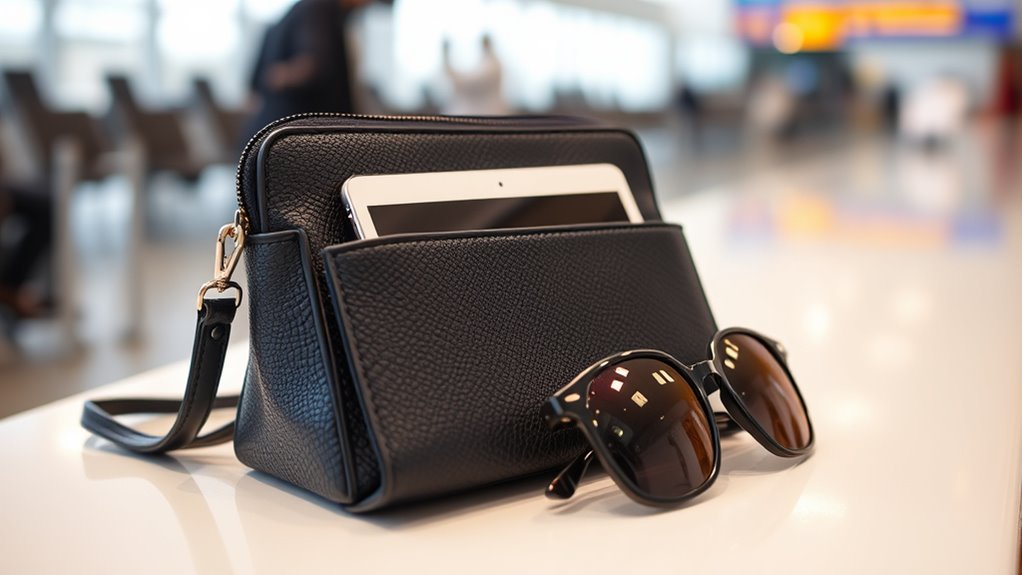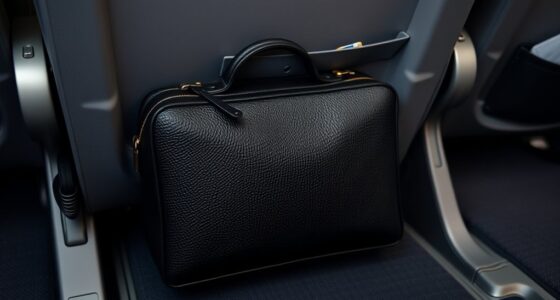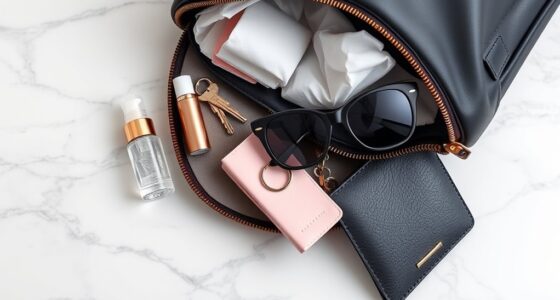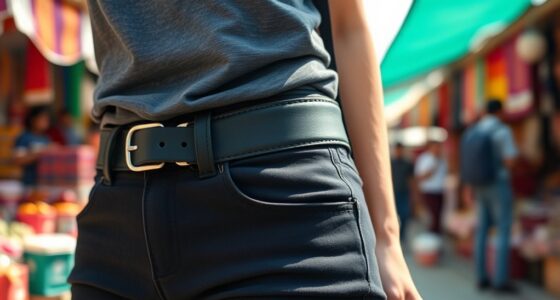Airlines typically allow a personal item measuring around 18 x 14 x 8 inches, including straps and wheels, but check specific rules. A personal item like a purse, tote, or compact backpack should fit under the seat in front of you. To stay within limits, measure your bag accurately and choose lightweight, organized styles. If your bag’s size varies, there are easy ways to handle discrepancies and make sure your essentials travel smoothly—learn more below.
Key Takeaways
- Most airlines allow personal items up to approximately 18 x 14 x 8 inches, but specific limits vary by airline.
- A purse, tote, or small backpack typically qualifies as a personal item if it fits under the seat.
- Measure your bag with a flexible tape, including straps and handles, to ensure compliance with size restrictions.
- Personal items should be lightweight, organized, and easy to carry to meet airline guidelines comfortably.
- If your bag exceeds size limits at the gate, politely ask staff about checking options or transferring items.
Common Size Limits for Personal Items Across Airlines
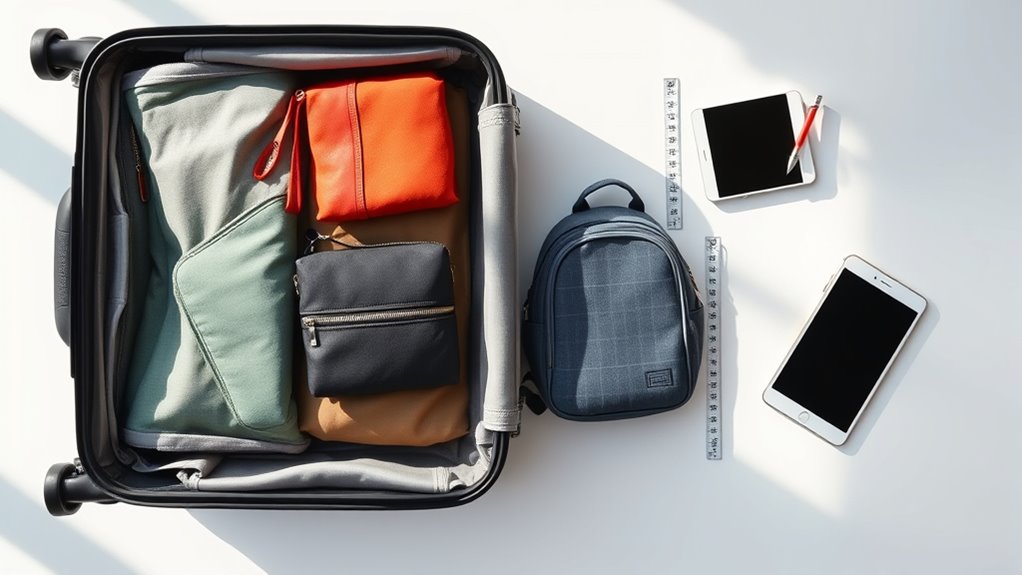
Most airlines set their personal-item size limits within a similar range, making it easier for travelers to know what to pack. When comparing carry-on vs personal items, understanding airline baggage policies is essential. Typically, personal items should measure around 18 x 14 x 8 inches, including handles and wheels, though some airlines allow slightly larger sizes. These policies help guarantee your bag fits under the seat or in overhead compartments. Keep in mind, each airline may have slight variations, so always check their specific rules before packing. Staying within these size limits prevents delays at security and ensures your belongings stay with you during the flight. Knowing common size limits simplifies packing and helps you avoid surprises at the gate. Additionally, considering the overall style and materials of your personal item can impact how well it fits within airline guidelines.
What Counts as a Personal Item or Purse?
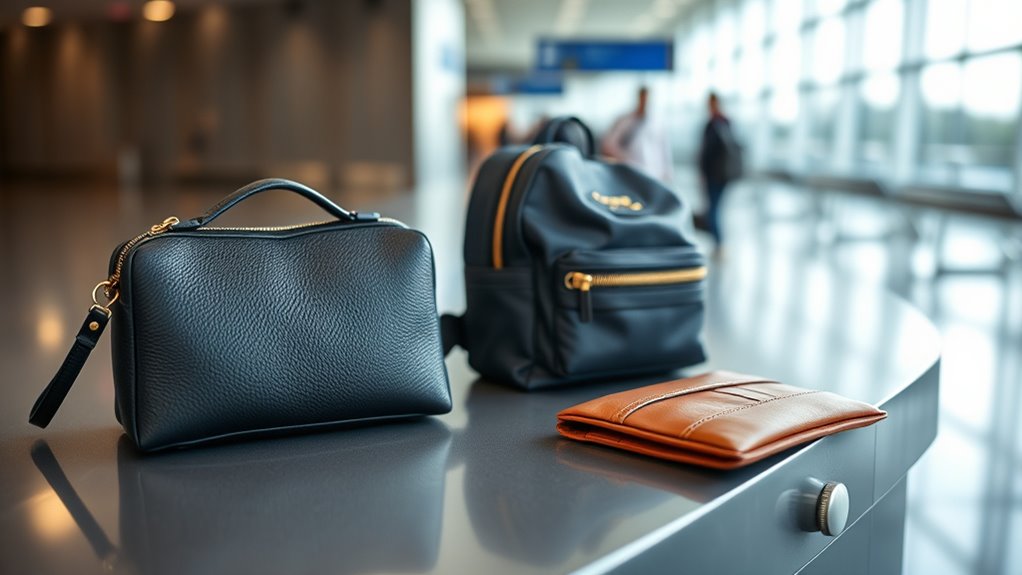
Ever wonder what really qualifies as a personal item or purse on a flight? Luggage security and carry-on restrictions vary by airline, but generally, your personal item includes a small bag that fits under the seat in front of you. This could be a purse, a tote, or a small backpack. The key is size—most airlines specify dimensions, so your item shouldn’t be too bulky. Items like wallets, small handbags, or briefcases typically count, but larger bags usually don’t. Keep in mind that your personal item should complement your carry-on, not replace it. Airlines want to ensure both items fit within their size limits for safety and convenience. Knowing what counts as a personal item helps you pack smartly and avoid any issues at security checkpoints. Additionally, understanding home theatre projector specifications can enhance your entertainment setup at home.
How to Measure Your Bag to Meet Airline Requirements

To guarantee your personal item meets airline size limits, you’ll need to measure it accurately before packing. Start by using a flexible measuring tape to get the overall length, width, and height. Keep in mind material considerations; softer materials may compress, so measure at full extension. Be aware of weight restrictions, especially if your bag is bulky or heavy when filled. For added assurance, consider cultural breakfast traditions that may influence the types of items you pack, ensuring your bag remains within size limits. Consider these tips:
- Measure from the base to the highest point, including handles or straps
- Use a flat surface to ensure accuracy
- Check airline-specific size limits for combined dimensions
- Account for material flexibility, which can affect the bag’s final size
This careful measurement process helps you stay within airline guidelines and avoid surprises at the gate.
Tips for Choosing the Perfect Personal Item for Travel
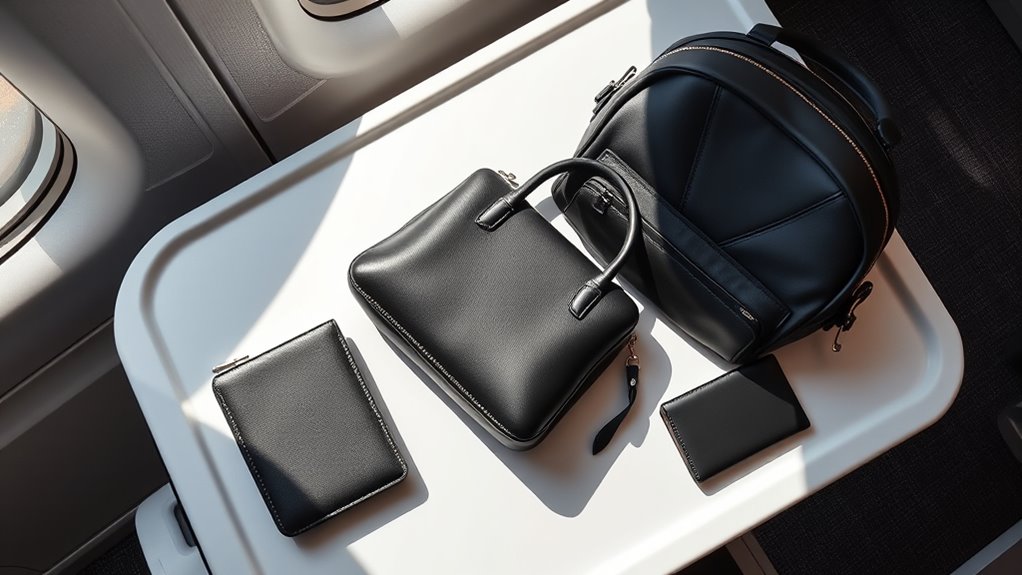
Choosing the right personal item can make a significant difference in how smoothly your trip goes. Select travel accessories that are lightweight, versatile, and fit within airline size limits to maximize convenience. Consider a bag with multiple compartments to organize essentials efficiently and make packing strategies easier. Opt for a style that’s easy to carry, whether a backpack, tote, or crossbody, based on your needs. Prioritize durability and quick access to items like your phone, passport, and snacks. Avoid overpacking by choosing a compact bag that holds your essentials without becoming bulky. Remember, a well-chosen personal item reduces stress at security and keeps your valuables accessible throughout your journey. Being aware of airline personal-item size rules can help you avoid surprises at the gate and streamline your boarding process. With thoughtful selection, your travel experience becomes more enjoyable and hassle-free.
Handling Size Discrepancies and What to Do at the Gate

When your personal item exceeds the airline’s size limits, it’s important to stay calm and handle the situation promptly. Approach the gate staff politely and use effective gate strategies to resolve the issue smoothly. You can:
- Ask if there’s an opportunity to check the bag at no extra cost.
- Offer to transfer items to your carry-on or checked luggage.
- Inquire about available storage options or bag squishing techniques.
- Remain courteous, demonstrating good customer service tactics to foster cooperation.
- Remember that understanding the size and features of toilets can help you better pack and organize your luggage to avoid such issues.
Frequently Asked Questions
Are There Any Fees for Bringing Oversized Personal Items?
You might face fees for bringing oversized personal items, depending on the airline’s extra baggage policies. If your item exceeds the size limits, airlines often charge additional fees during check-in or boarding. During security screening procedures, oversized items can cause delays or require special handling. To avoid surprises, check your airline’s specific rules beforehand, and pack within the allowed dimensions to save time and money.
Can I Bring Multiple Personal Items on Board?
You might wonder if you can bring multiple personal items on board, but airline policies usually limit you to one personal item per passenger. While some airlines are flexible, exceeding personal item dimensions could mean paying extra fees or checking items. To avoid surprises, check your airline’s specific policies beforehand. Bringing multiple personal items can be tempting, but adhering to size limits ensures a smooth, stress-free boarding experience.
Do Personal Item Rules Vary for International Flights?
When flying internationally, personal item rules can differ due to international regulations and regional airline policies. You should always check your airline’s specific guidelines before packing, as some may have stricter size or weight limits for personal items. It’s important to stay informed about these variations to avoid issues at security or boarding. Always review your airline’s policies to make certain your personal item meets their requirements for international travel.
Are There Restrictions on Personal Items With Wheels?
You might wonder if there are restrictions on wheeled carry-ons as personal items. Generally, airlines specify personal item dimensions, and wheeled bags often fall into this category if they fit under the seat. However, some airlines may have size or weight limits for wheeled personal items, so it’s best to check your airline’s specific rules before traveling. Keep your wheeled carry-on within the allowed dimensions to avoid extra fees or hassles.
How Do Personal Item Rules Differ for Different Cabin Classes?
Your question about how personal item rules differ across cabin classes is spot on. Cabin class policies vary greatly—luxury airline rules are often more generous, allowing larger or extra items to match premium comfort levels. In economy, restrictions are tighter to maximize space, while first class travelers usually enjoy relaxed personal item sizes and additional allowances. So, your experience depends on whether you’re flying economy or luxury, shaping how much you can carry onboard.
Conclusion
Now that you know the ins and outs of personal-item sizes, you’re practically a travel pro! With this knowledge, you can breeze through check-in and avoid the chaos of last-minute gate checks. Think of your bag as your trusty sidekick, ready to conquer skies with ease. So pack smart, measure twice, and fly confident — because a well-packed personal item can be your ticket to stress-free travel, making airport chaos look like a distant memory.
